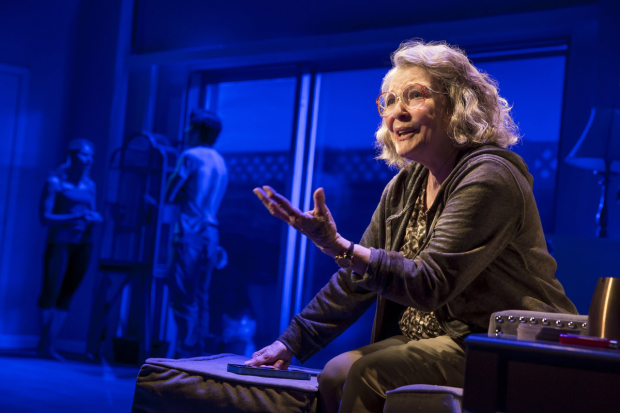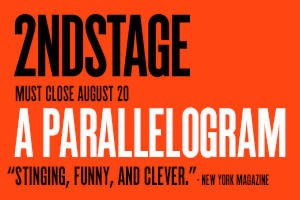A Parallelogram
The author of ”Clybourne Park” applies quantum mechanics to an ancient dramatic quandary.

(© Joan Marcus)
Bee has a remote control that allows her to rewind the world and watch herself as a younger woman. She views these scenes from her earlier life as one would a mildly entertaining soap opera, the kind during which you can play solitaire and not miss much. According to her, none of the choices she made really mattered, so why go back and rehash them? Is free will merely an illusion? As compelling as that eternal question of the stage is, we're not even sure it's the right one to ask about A Parallelogram, Bruce Norris's undeniably intelligent and multilayered play now making its long-awaited New York debut at Second Stage Theatre (it premiered at Chicago's Steppenwolf Theatre in 2010). This comedy with a bitter dramatic aftertaste will leave you pondering what exactly you just saw for days after.
The play opens with the younger Bee (Celia Keenan-Bolger) seated on her bed in the ground floor apartment she shares with her boyfriend, Jay (Stephen Kunken exuding a proud obliviousness). Jay monologues about how white-collar white guys like him are always portrayed unsympathetically in movies and plays (this is one of Norris's more self-conscious flourishes). This goes on for several minutes as as his Latino landscaper, JJ (the confident and alluring Juan Castano), mows the grass outside in the sweltering heat.

(© Joan Marcus)
Bee 2 (which is how the program lists her, and who is played by Anita Gillette) comments on the action to her younger self (the only character who can see and hear her). She occasionally rewinds a moment to give Bee the opportunity to make a different choice, if only to prove how fruitless an exercise that is. Bee's fate is sealed: "You’re going to look in the mirror one day, and you’re gonna see a fat, nearsighted old woman who spends every night alone smoking cigarettes and watching TV," she says as she reaches for a baggie of Oreos.
As the play's only character with the power to directly address the audience, Bee 2 is the primary conduit of the playwright's breezy misanthropy, the least of which is expressed in Norris's halfhearted attempt to give his characters distinctive names. Why bother coming up with creative names when none of these people actually matter? "A hundred years from now you think people are gonna remember you," Bee 2 dryly confronts the audience, "Why, 'cuzza all the pictures you took with your phone?"
There's an intoxicating truthiness in Bee 2's cynicism, especially as delivered by Gillette, who humorously conveys the assertive world-weariness of the old. Like a jester in a medieval court, she touches on taboo subjects most would avoid, like the Holocaust and 9/11. Raising an eyebrow, she derisively asks, "Never forget?" She scoffs at our false wisdom, asserting that we're mostly concerned with our own little lives. There will always be some fresh tragedy to never forget. In her case, it's a global pandemic that wipes out most of humanity. She comments on the aftermath, "What nobody really wants to admit out loud is: It’s actually kind of an improvement."

(© Joan Marcus)
Those horrified by Gillette's anti-Pollyanna will find a champion in Keenan-Bolger, who endows Bee with a spark of scrappy optimism. She also effortlessly draws out the comedy in the script, even as Bee's life hurtles inevitably toward tragedy. It's not just the tragedy of turning into Bee 2, either, which isn't so bad when we consider several other terrible alternatives. No matter how dark he goes, Norris always leaves the door open, if not for a happy ending, at least a bearable one.
Norris (who is best known for his Pulitzer Prize-winning gentrification drama Clybourne Park) has us mentally firing on all cylinders. Every beat seems to bring a new insight or argument to consider: Is demography destiny? Are we entirely beholden to the chemical reactions occurring in our fragile bodies? Should we trust a narrator in the theater just because she's the only one who acknowledges our presence?

(© Joan Marcus)
Director Michael Greif keeps all of these questions floating through the air in a well-staged, sharply designed production. Not only do all the actors fully commit to meticulously recreating the same moments over and over again (Castano and Kunken are real troopers in this regard), but the pacing never flags or falters. Rachel Hauck's nifty whirling set facilitates head-spinning transitions, while Kenneth Posner's lighting goes from natural to supernatural in an instant. Greif and Norris steadily accelerate the flow of ideas and dramatic possibilities all the way to the end as we work to keep up with a play that always feels a few steps ahead of us. Trust me: The chase is worth it.









